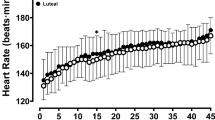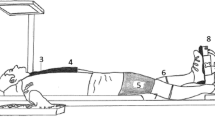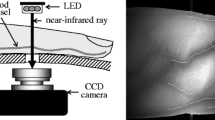Summary
To investigate the effects of the menstrual cycle and of exercise intensity on the relationship between finger blood flow (FBF) and esophageal temperature (Tes), we studied four women, aged 20–32 years. Subjects exercised at 40% and 70%\(\dot V_{O_{2_{\max } } } \) in the semi-supine posture at an ambient temperature of 20‡ C. Resting Tes was higher during the luteal phase than the follicular phase (P<0.01). There were no significant differences between the two phases in FBF, oxygen consumption, carbon dioxide production, heart rate or minute ventilation at rest and during exercise, respectively. Each regression line of the FBF-Tes relationship consists of two distinct segments of FBF change to Tes (slope 1 and 2). FBF increased at a threshold Tes for vasodilation ([Tes 0]) and the rate of FBF rise became greater at another Tes above this threshold ([Tes 0']). For both levels of exercise, [Tes 0] and [Tes 0'] were shifted upward during the luteal phase, but the slopes of the FBF-Tes relationship were almost the same in the two phases of the menstrual cycle. Increasing exercise intensity induced a significant decrease in slope 1 of the FBF-Tes relationship during the follicular (P<0.01) and the luteal phases (P<0.02), respectively. These results show that the set-point temperature may be shifted towards a higher level during the luteal phase of the menstrual cycle during exercise and that, as in males, the thermoregulatory vasodilator response is attenuated by increasing exercise-induced vasoconstrictor tone in proportion to exercise intensity during both phases of the menstrual cycle when heat storage is insufficient in women.
Similar content being viewed by others
References
Brouha L, Smith PE, De Lanne R, Maxfield ME (1960) Physiological reactions of men and women during muscular activity and recovery in various environments. J Appl Physiol 16:133–140
Cunningham DJ, Cabanac M (1971) Evidence from behavioral thermoregulatory responses of a shift in setpoint temperature related to the menstrual cycle. J Physiol [Paris] 63:236–238
Davis ME, Fugo NW (1948) The cause of physiologic basal temperature changes in women. J Clin Endocrinol 8:550–563
Dill CB, Yousef K, Nelson JD (1973) Response of men and women to two-hour walks in desert heat. J Appl Physiol 35:231–235
Hales JRS, Fawcett AA, Bennett JW, Needham AD (1978) Thermal control of blood flow through capillaries and arteriovenous anastomoses in skin of sheep. Pflügers Arch 378:55–63
Hirashita M, Hirai A, Takahata T, Nunomura T, Nagasaka T (1984) Shift of setpoint temperature to increase non-evaporative heat loss related to the menstrual cycle. J Aerospace Environ Med 21:29–34
Hirata K, Nagasaka T, Hirai A, Hirashita M, Takahata T (1984a) Suppression of finger vasodilator response during exercise in proportion to its intensity. In: Hales JRS (ed) Thermal physiology. Raven Press, New York, pp 381–384
Hirata K, Nagasaka T, Hirai A, Hirashita M, Takahata T (1984b) Cutaneous vascular tone during heat load modified by exercise intensity. J Therm Biol 9:117–120
Horvath SM, Drinkwater BL (1982) Thermoregulation and the menstrual cycle. Aviat Space Environ Med 53:790–794
Johnson JM, Park MK (1982) Effect of heat stress on cutaneous vascular responses to the initiation of exercise. J Appl Physiol 53:744–749
Johnson JM, Rowell LB, Brengelmann GL (1974) Modification of the skin blood flow-body temperature relationship by upright exercise. J Appl Physiol 37:880–886
Jurkowski JE, Jones NL, Walker WC, Younglai EV, Sutton JR (1978) Ovarian hormonal responses to exercise. J Appl Physiol 44:109–114
Jurkowski JEH, Jones NL, Toews CJ, Sutton JR (1981) Effects of menstrual cycle on blood lactate, O2 delivery, and performance during exercise. J Appl Physiol 51:1493–1499
Nadel ER (1977) A brief overview. In: Nadel ER (ed) Problems with temperature regulation during exercise. Academic Press, New York, pp 1–10
Nadel ER (1980) Circulatory and thermal regulations during exercise. Fed Proc 39:1491–1497
Roberts MF, Wenger CB, Stolwijk JAJ, Nadel ER (1977) Skin blood flow and sweating changes following exercise training and heat acclimation. J Appl Physiol 43:133–137
Sherman JL (1963) Normal arteriovenous anastomoses. Medicine [Baltimore] 42:247–267
Stephenson LA, Kolka MA, Wilkerson JE (1982) Metabolic and thermoregulatory responses to exercise during the human menstrual cycle. Med Sci Sports Exerc 14:270–275
Stephenson LA, Wenger CB, O'Donovan BH, Nadel ER (1984) Circadian rhythm in sweating and cutaneous blood flow. Am J Physiol 246:R321-R324
Vroman NB, Beckett WS, Permutt S, Fortney S (1985) Effect of positive-pressure breathing on cardiovascular and thermoregulatory responses to exercise. J Appl Physiol 58:876–881
Wenger CB, Roberts MF, Stolwijk JAJ, Nadel ER (1975) Forearm blood flow during body temperature transients produced by leg exercise. J Appl Physiol 38:58–63
Wenger CB, Roberts MF, Stolwijk JAJ, Nadel ER (1976) Nocturnal lowering of threshold for sweating and vasodilation. J Appl Physiol 41:15–19
Whitney RJ (1953) The measurement of volume changes in human limbs. J Physiol 121:1–127
Author information
Authors and Affiliations
Additional information
Supported in part by Grant-in-Aid for Scientific Research from the Ministry of Education, Science and Culture of Japan (grant no. 57770137)
Rights and permissions
About this article
Cite this article
Hirata, K., Nagasaka, T., Hirai, A. et al. Effects of human menstrual cycle on thermoregulatory vasodilation during exercise. Europ. J. Appl. Physiol. 54, 559–565 (1986). https://doi.org/10.1007/BF00943341
Accepted:
Issue Date:
DOI: https://doi.org/10.1007/BF00943341




